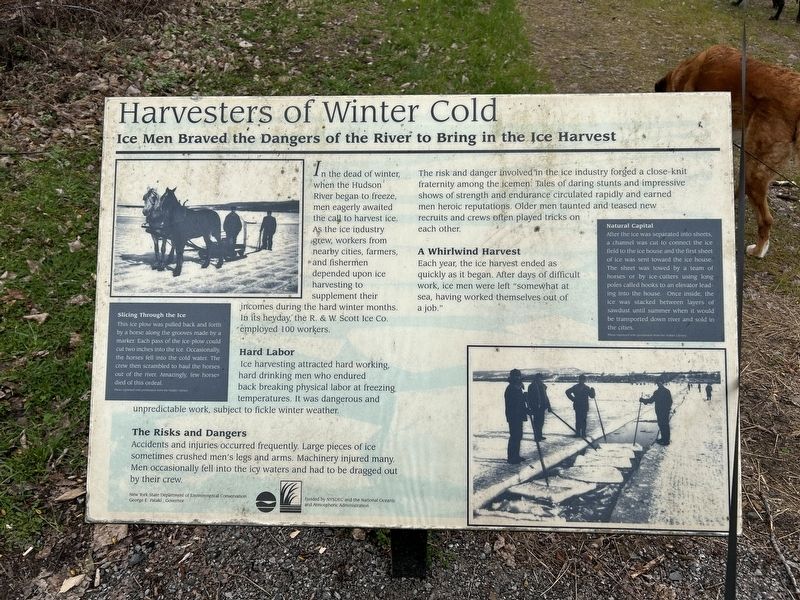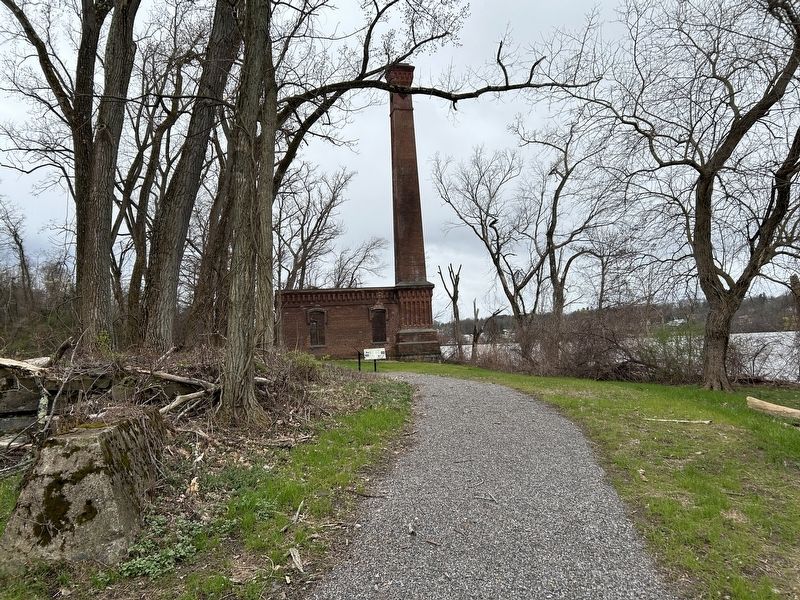Near Stuyvesant in Columbia County, New York — The American Northeast (Mid-Atlantic)
Harvesters of Winter Cold
Ice Men Braved the Dangers of the River to Bring in the Ice Harvest
In the dead of winter, when the Hudson River began to freeze, men eagerly awaited the call to harvest ice. As the ice industry grew, workers from nearby cities, farmers, and fishermen depended upon ice harvesting to supplement their incomes during the hard winter months. In its heyday, the R. & W. Scott Ice Co. employed 100 workers.
Hard Labor
Ice harvesting attracted hard working. hard drinking men who endured back breaking physical labor at freezing temperatures. It was dangerous and unpredictable work, subject to fickle winter weather.
The Risks and Dangers
Accidents and injuries occurred frequently. Large pieces of ice sometimes crushed men's legs and arms. Machinery injured many. Men occasionally fell into the icy waters and had to be dragged out by their crew. The risk and danger involved in the ice industry forged a close-knit fraternity among the icemen: Tales of daring stunts and impressive shows of strength and endurance circulated rapidly and earned men heroic reputations. Older men taunted and teased new recruits and crews often played tricks on each other.
A Whirlwind Harvest
Each year, the ice harvest ended as quickly as it began. After days of difficult work, ice men were left "somewhat at sea, having worked themselves out of a job."
[Captions:]
Slicing Through the Ice
This ice plow was pulled back and form by a horse along the grooves made by marker. Each pass of the ice-plow could cut two inches into the ice. Occasionally the horses fell into the cold water. The crew then scrambled to haul the horses out of the river. Amazingly, few horses died of this ordeal.
Natural Capital
After the ice was separated into sheets, a channel was cut to connect the ice field to the ice house and the first sheet of ice was sent toward the ice house. The sheet was led by a team of horses or by ice-cutters using long poles called hooks to an elevator leading into the house. Once inside, the ice was stacked between layers of sawdust until summer when it would be transported down river and sold in the cities
Topics. This historical marker is listed in this topic list: Industry & Commerce.
Location. 42° 21.477′ N, 73° 47.331′ W. Marker is near Stuyvesant, New York, in Columbia County. Marker can be reached from Ice House Road, 0.2 miles west of Route 9J. Marker is reached on foot following the trail from the parking lot at the end of Ice House Road. Touch for map. Marker is at or near this postal address: Ice House Road, Stuyvesant NY 12173, United States of America. Touch for directions.
Other nearby markers. At least 8 other markers are within walking distance of this marker. Stockport Flats: The Nutten Hook Unique Area (about 400 feet away, measured in a direct line); Newton Hook (approx. 0.3 miles away); Nutten Hooke (approx. 0.4 miles away); In Memory (approx. half a mile away); Reed’s Landing (approx. half a mile away); Heermance Library (approx. 0.6 miles away); “First House On The Hill” (approx. 0.7 miles away); Honor Roll (approx. 0.9 miles away). Touch for a list and map of all markers in Stuyvesant.
Also see . . .
1. Ice Harvesting on the Hudson River. (Submitted on April 14, 2024, by Steve Stoessel of Niskayuna, New York.)
2. Columbia County Historical Society Artifacts of Industry Tour. This small park is home to the ruins of the largest ice house on the Hudson. Built 1885, the R. and W. Scott ice house featured four elevators which hauled ice from the Hudson’s edge. By the 1930s mechanical refrigeration had turned the ice harvesting industry obsolete. The walls remain intact, with a brick stack that rises into the trees; inside, machine bases are still visible, as is the decorative brickwork around the chimney. (Submitted on April 15, 2024, by Steve Stoessel of Niskayuna, New York.)
Credits. This page was last revised on April 21, 2024. It was originally submitted on April 14, 2024, by Steve Stoessel of Niskayuna, New York. This page has been viewed 59 times since then. Photos: 1, 2. submitted on April 14, 2024, by Steve Stoessel of Niskayuna, New York. • Michael Herrick was the editor who published this page.

